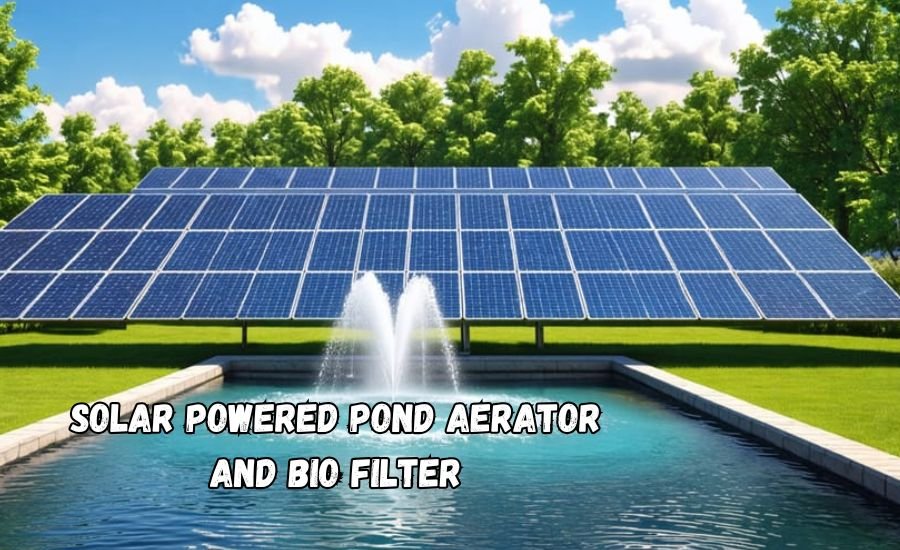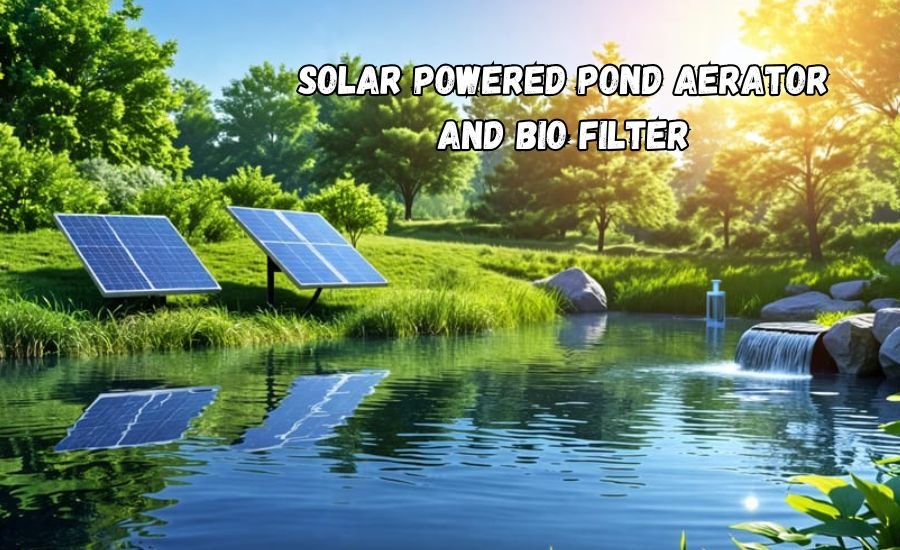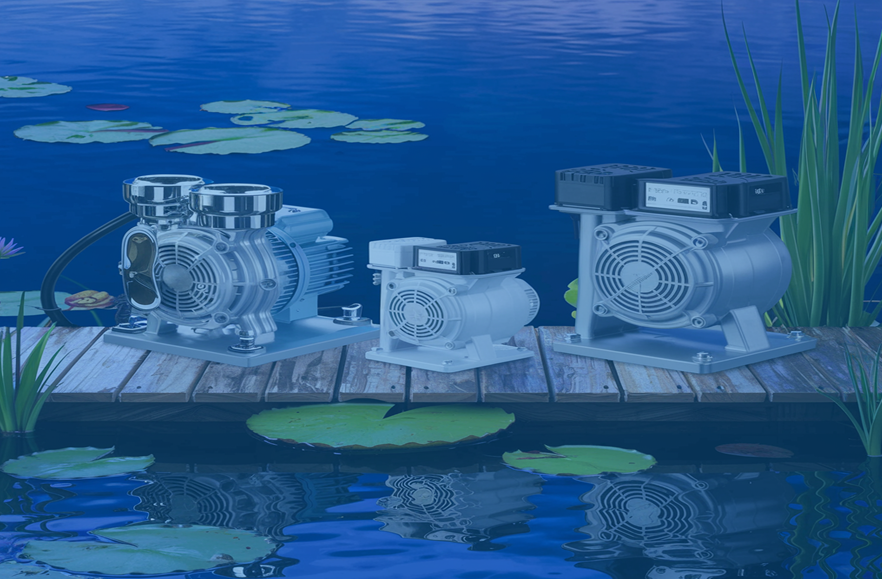Solar Powered Pond Aerator and Bio Filter: The Ultimate Guide

A thriving pond isn’t just a beautiful addition to your outdoor space; it’s a complex ecosystem that needs careful maintenance to keep its plants, fish, and water healthy. While ponds are naturally oxygenated and filtered in the wild, garden and backyard ponds often require additional help. That’s where a solar powered pond aerator and bio filter comes in. This eco-friendly setup helps maintain a clean, well-oxygenated pond environment, providing essential benefits for both aesthetic and practical reasons.
In this guide, we’ll explore everything you need to know about solar powered pond aerators and bio filters. You’ll learn why aeration and filtration are essential for a pond’s health, how solar power offers an eco-friendly alternative, and what to look for when choosing and maintaining a system. Whether you’re a new pond owner or looking to upgrade your pond care, this article will give you the knowledge to make the best choice.
Why Aeration and Filtration Are Essential for Ponds
Healthy ponds depend on a balance of oxygenation and filtration. But why exactly do ponds need aerators and bio filters?
Oxygen Levels and Aeration
Pond water needs oxygen to support fish, beneficial bacteria, and plants. In a natural pond, wind and water movement help keep oxygen levels balanced. However, in man-made ponds, water can become stagnant, leading to low oxygen levels, which harm fish and other aquatic life.
Algae Control and Water Clarity
Without sufficient oxygen, algae blooms can take over, turning the water green and clogging up your pond. Aerators help prevent this by circulating oxygen throughout the pond, creating an environment where beneficial bacteria can thrive and outcompete algae.
The Role of Bio Filters
Bio filters support pond health by breaking down organic waste, uneaten fish food, and other contaminants. Without a bio filter, this waste can build up, causing water to become murky and even toxic. Bio filters work alongside aerators to create a clean, clear pond that’s healthy for plants and fish alike.
What Is a Solar Powered Pond Aerator?

A solar powered pond aerator is a device that pumps oxygen into pond water using energy collected from the sun. Unlike traditional electric aerators, solar aerators are powered by solar panels, making them environmentally friendly and cost-effective over time.
How Solar Aerators Work
Solar aerators consist of three main parts:
- Solar Panels – Capture sunlight and convert it into electrical energy to power the aerator pump.
- Pump – The heart of the aerator, which pushes air through the tubing into the pond.
- Air Stones – The end of the tubing, where the air is released into the water, forming bubbles that help oxygenate the pond.
Solar aerators are most effective in sunny climates, where they can draw consistent power. They offer several advantages over electric models, including the elimination of ongoing electricity costs and reduced environmental impact.
How Bio Filters Work in a Pond System
Bio filters are a crucial part of a pond’s filtration system. They clean the water by using beneficial bacteria that break down harmful toxins and waste.
Types of Filtration in a Pond
- Mechanical Filtration – Captures large particles like leaves and debris.
- Biological Filtration – Utilizes beneficial bacteria to break down harmful substances like ammonia and nitrites, transforming them into less toxic nitrates. The bacteria live on the surfaces of bio filter media, where they process waste and improve water quality.
How Bio Filters and Aerators Work Together
While the aerator oxygenates the water, the bio filter handles waste management. This dynamic duo creates a balanced, self-sustaining pond environment that requires minimal chemical intervention.
Benefits of a Solar Powered Pond Aerator and Bio Filter Combination
Combining a solar powered aerator with a bio filter brings multiple benefits that improve your pond’s health, save on energy costs, and support a sustainable ecosystem.
1. Environmentally Friendly
Solar-powered systems reduce your carbon footprint and use renewable energy, minimizing the environmental impact of pond maintenance.
2. Cost Savings
While the initial investment in solar equipment can be higher, the savings on electricity bills make it cost-effective over time. Solar systems are also relatively low-maintenance, reducing long-term care costs.
3. Enhanced Water Quality
Solar aerators and bio filters create an ideal environment for fish and plants, improving water clarity and reducing the risk of harmful algae blooms. This combination provides a clean and healthy ecosystem for your pond.
Read More: FINBUSINES
How to Choose the Right Solar Powered Pond Aerator and Bio Filter
Choosing the right aerator and bio filter for your pond involves evaluating several factors, from pond size to equipment specifications.
Key Considerations
- Pond Size – A larger pond will require a more powerful aerator and larger bio filter.
- Solar Panel Wattage – Higher wattage means more power for aeration, especially in lower light conditions.
- Pump Capacity – Measured in gallons per hour (GPH), the pump capacity should match the size and needs of your pond.
- Durability and Warranty – Look for equipment with weatherproof components and a solid warranty.
Popular Models and Recommendations
- Brand A Solar Aerator – Known for its durability and high efficiency.
- Brand B Bio Filter – Features a compact design, easy to clean, and efficient waste processing.
When purchasing a system, look for features like ease of installation, low maintenance requirements, and good customer support to get the most out of your investment.
Installation Guide for Solar Powered Aerators and Bio Filters

Installing a solar powered aerator and bio filter is relatively straightforward, but proper setup ensures the system runs optimally.
Step-by-Step Installation
- Set up the Solar Panel – Place it in an area with maximum sun exposure.
- Connect the Tubing – Run tubing from the pump to the air stones or filter intake.
- Position the Air Stone – Place it at the deepest point in your pond for maximum oxygen distribution.
- Test the System – Ensure the pump operates effectively and check for steady airflow.
Maintenance Tips
- Regularly Clean the Filter Media – Prevent clogs by rinsing filter media every few months.
- Check Solar Panel Positioning – Ensure no obstructions block sunlight from the panel.
- Inspect Tubing and Connections – Make sure all parts are securely connected to avoid leaks.
Troubleshooting Common Issues
Despite the durability of solar powered aerators and bio filters, occasional issues can arise. Here’s a quick troubleshooting guide:
Common Problems
- Low Aeration – May result from debris clogging the air stone or low sunlight levels.
- Filter Clogs – Often caused by buildup in the filter media; regular cleaning helps prevent this.
- Solar Panel Obstruction – Ensure the panel receives ample sunlight; trim any nearby plants or remove obstructions.
Solutions
Most issues can be resolved with routine maintenance, proper cleaning, and ensuring the solar panel remains unobstructed.
Conclusion and Final Tips
Maintaining a healthy pond doesn’t have to be a chore, especially when you have the right tools. A solar powered pond aerator and bio filter provide eco-friendly, cost-effective solutions that enhance your pond’s health, improve water quality, and support a balanced ecosystem. By investing in solar technology, you’re not only reducing your energy bills but also supporting sustainable pond care.
FAQs
Q: How does a solar powered pond aerator work?
A: A solar powered pond aerator uses solar panels to capture sunlight and convert it into energy, which powers a pump that pushes air into the pond, oxygenating the water without relying on electricity.
Q: Why are bio filters important for a pond?
A: Bio filters remove harmful waste and toxins from the water using beneficial bacteria, which break down organic matter to keep the pond water clear and safe for fish and plants.
Q: What are the benefits of using solar power for pond aeration?
A: Solar power is eco-friendly, cost-effective, and sustainable, reducing electricity costs while providing a continuous, renewable energy source for pond aeration.
Q: Can a solar powered aerator and bio filter handle a large pond?
A: Yes, but it’s essential to choose a solar aerator and bio filter with sufficient power and capacity to match the size of your pond for effective results.
Q: Do solar powered aerators work on cloudy days?
A: Solar aerators perform best in direct sunlight, but many models include battery backups or larger panels to store energy and work efficiently even on cloudy days.
Q: How often should I clean my bio filter?
A: Bio filters should be cleaned every few months to prevent clogs, but avoid over-cleaning to preserve beneficial bacteria needed for breaking down waste.
Q: Is it difficult to install a solar powered pond aerator and bio filter?
A: No, most systems are designed for easy DIY installation. Position the solar panel in a sunny area, connect tubing, and place the aerator or filter according to the manufacturer’s instructions.
Check Out the Latest Blogs Regarding: Align-Technology-Share-Price-100-400-Invisalign-Cost






